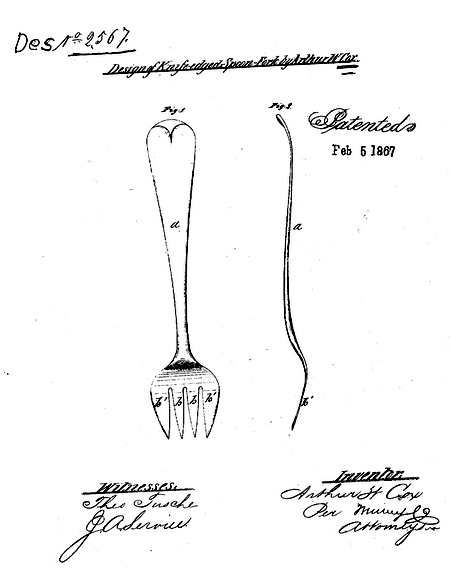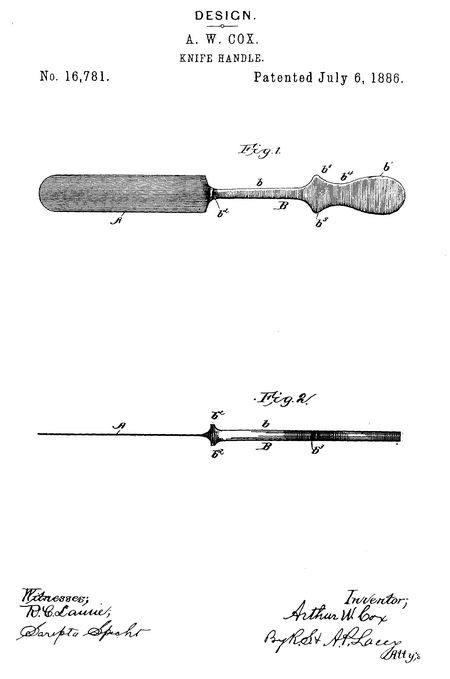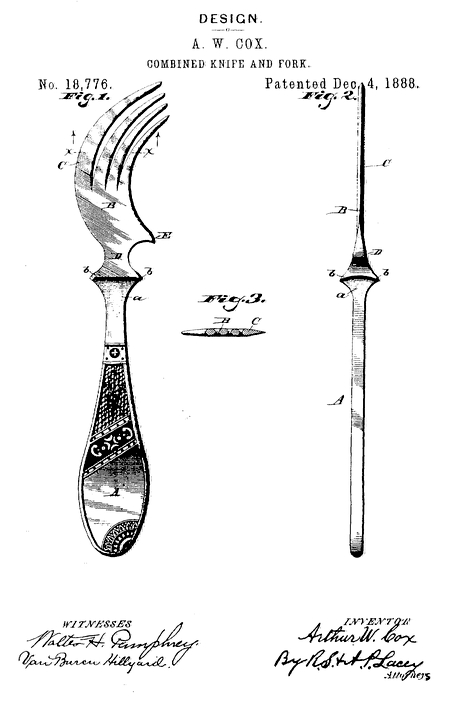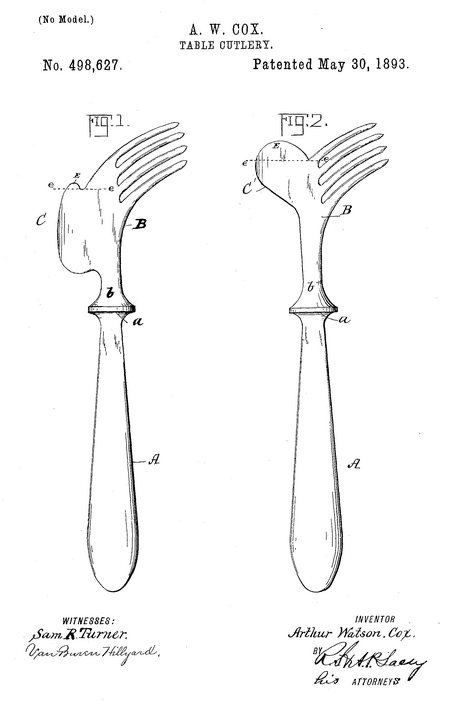Arthur Watson Cox
- Born: 26 Nov 1840, Malden MA
General notes:
Designer
Events in his life were:

- Patent: 2567, on 2 Feb 1867. DESIGN FOR A KNIFE-EDGED FORK,
To all whom it may concern:
Be it known that I, Arthur W. Cox, of Malden, in the county of Middlesex, and State of Massachusetts, have invented a new and improved Design for a Knife-Edged Spoon-Fork; and I do hereby declare that the following is a full, clear, and exact description thereof, which will enable those skilled in the art to make and use the same, reference being had to the accompanying drawing, forming part of this specification, in which—
Figure 1 is a front view of my improved design for a table fork.
Figure 2, an edge view.
Similar letters of reference indicate corresponding parts.
The handle a of my improved knife-edged spoon-fork is made in the usual form for table forks or spoons, of suitable metal, and the bowl is divided into four prongs, the two middle prongs, b b, being made taper and pointed, similar to the tines or prongs of ordinary table forks, but comparatively short and not extending back as far as commonly made, so that a broad space or surface is formed behind the base of the prongs. The two outside prongs, b'b', are made very broad at the base, and the outer edges are curved in an elliptical form like the bowl of a spoon; the outer edges of the prongs b' b' are also bevelled or sharpened somewhat like the blade of a knife; thus combining in the same design the advantages of a spoon and a fork having a knife-edge on the sides.
Having thus described my invention, what I claim as new, and desire to secure by Letters Patent, is—
The design of a knife-edged spoon-fork, formed as herein described and shown.
ARTHUR W. COX.
Witnesses:
Jos. W. Tufts, Jr.
Chas. A. Whittemore.

- Patent: 16,781, on 6 Jul 1886. ARTHUR W. COX, OF BALLARD VALE, MASSACHUSETTS.
DESIGN FOR A KNIFE-HANDLE.
Specification forming part of Design No. 16,781, dated July 6, 1886.
Application filed May 22, 1888. Serial No. 203,048. Term of patent 14 years
To all whom it may concern:
Be it known that I, Arthur W. Cox, a citizen of the United States, residing at Ballard Vale, in the county of Essex and State of Massachusetts, have invented and produced a new and original Design for Knife-Handles; and I do declare the following to be a full, clear, and exact description of the invention, such as will enable others skilled in the art to which it appertains to make and use the same, reference being had to the accompanying drawings, and to the letters and figures of reference marked thereon, which form a part of this specification.
Figure 1 is a plan view of my newly-designed knife. Fig. 2 is an edge view of the same.
The leading feature of my design consists in a handle for table-cutlery expanded laterally on each side of the blade, and extending therefrom at a point about midway between its edges, forming a long narrow neck portion, which, at a distance from the blade curving symmetrically outward in opposite directions in the plane of the blade and back toward each: other, forms points and: terminates in an expanded and curved end, as clearly shown in the plan: view of Fig. 1. The doubled-edge blade A is provided with the handle B, projecting therefrom about midway between its edges. The handle comprises the long neck portion b and the rounded and expanded end b'. At the inner end the neck: b is expanded laterally on each side of the blade into rests b". The opposite end, curving outwardly and inwardly symmetrically in opposite directions in the plane of the blade, forms the projections b3 and the contracted portion b4. The inward curves are again deflected and gradually recede and approach and uniting, form the expanded and curved end b'.
I claim—
A design for handle for knives or kindred article: of table-ware herein shown and described, the same consisting of a handle having the narrow neck, expanded laterally at one end, on each side of the plane of the blades, and curving outward and inward, at the other end forming points which extend in the plane of the blade, the expanded end, and the contracted portion between the points and expanded end.
In testimony whereof I affix my signature in presence of two witnesses.
ARTHUR W. COX
Witnesses:
Samuel Bowker
Charles M. Marland

- Patent: 18,776, on 4 Dec 1888. ARTHUR W. COX, OF BALLARD VALE, MASSACHUSETTS. DESIGN FOR A COMBINED KNIFE AND FORK.
SPECIFICATION forming part of Design No. 18,776, dated December 4,1888.
Application filed October 27, 1888. Serial No. 289,343. Term of patent 3 1/2 years.
To all whom it may concern:
Be it known that I, Arthur W. Cox, a citizen of the United States, residing at Ballard Vale, in the county of Essex and State of Massachusetts, have invented and produced anew and original Design for a Combined Knife and Fork; and I do declare the following to be a full, clear, and exact description of the invention, such as will enable others skilled in the art to which it appertains to make and use the same, reference being had to the accompanying drawings, and to the letters and figures of reference marked thereon, which form a part of this specification.
This invention relates to a novel design for a combined knife and fork, which will be hereinafter more fully described, and shown in the accompanying drawings, in which—
Figure 1 is a side view of a combined knife and fork embodying my invention; Fig. 2, an edge view of the device, and Fig. 3 a section on the line x x of Fig. 1.
The leading feature of the design consists in the general form and outline of the article, and particularly in the contour of the fork, the prongs of which curve downwardly in the direction of their length, the sides of the lower prong converging to a knife-edge.
The handle A and the fork B are in the same straight plane, the handle contracting at a and expanding laterally and vertically at b. The fork B, contracted at D, curves downwardly between its end and the contracted portion D, or, in other words, is curved in the direction of its length. The lower prong, C, is beveled to a knife-edge, and the upper edge of the fork is provided with the vertical extension E, close to the vertical and laterally-expanded portion b.
Having thus described my invention, what I claim, and desire to secure by Letters Patent, is—
The design for a combined knife and fork, substantially as herein shown and described.
In testimony whereof I affix my signature in presence of two witnesses.
ARTHUR W. COX
Witnesses:
Howard Gannett
George T. Currier

- He was issued patent number 498,627 on 30 May 1893
ARTHUR WATSON COX, OF BALLARD VALE, MASSACHUSETTS, ASSIGNOR TO ALICE J. COX, OF SAME PLACE.
TABLE-CUTLERY.
SPECIFICATION forming part of Letters Patent No. 498,627, dated May 30, 1893.
Application filed July 5, 1890, Serial No. 357,856. (No model.)
To all whom it may concern:
Be it known that I, Arthur Watson Cox, a citizen of the United States, residing at Ballard Vale, in the county of Essex and State of Massachusetts, have invented certain new and useful Improvements in Knives and Forks; and I do hereby declare the following to be a full, clear, and exact description of the invention, such as will enable others skilled in the art to which it appertains to make and use the same.
This invention relates to a combined knife and fork; and aims to provide an article of cutlery which can be conveniently manipulated by one hand for cutting food in small dishes and for removing the separated particles therefrom, and which will enable the user to secure a perfectly free, easy and certain grasp of the implement by either hand whether it be used either as a knife or fork.
The improvement consists, essentially, of a straight handle having a shank in line with the handle and having tines projected from the side of the shank in symmetrically curved lines to form the fork, and having a cutter projected from the other side' of the shank in a diametrically opposite direction to the fork as hereinafter will more fully appear.
The improvement further consists in the novel features which herein after will be more particularly described and claimed, and which are shown in the annexed drawings, in which—
Figure 1 is a side view of a combined knife and fork embodying my invention. Fig. 2 is a similar view of a modified form.
The handle A is similar in each figure of the drawings, being straight and tapering from the rest a toward the end where it is largest. The shank o is in line with the handle and from one side thereof is projected in symmetrically curved lines the tines which compose the fork B as shown. The cutter is projected from the other edge of the shank in a diametrically opposite direction to the fork, and its front end projects forward of the line e e which is drawn at right angles to the shank from the point of contact of the cutter therewith to form what will be designated hereinafter as the front extension E of the cutter. In Fig. 1 this cutter C extends along on the shank b some distance, whereas in Fig. 2, the cutter C is located at the end of the shank directly opposite the fork and is semi-circular in form. The rest a is provided for the finger or thumb to obtain a purchase on in the service of the implement, and to form a bolster to keep the fork and cutter from contact with the table linen.
The combined knife and fork can be used in either hand and admits of the separation of food in small deep dishes without elevating the handle to nearly a vertical position as is required by similar implements as generally constructed. It also permits food to be conveyed to the mouth in an easy, pleasant and graceful manner, in that the hand and arm do not have to describe so large a circle as with other knife forks, or with the ordinary table knife or fork.
For the purpose of economy and cleanliness the handle, rest, shank, tines and cutter are integrally formed. It will be observed that the front extension E of the cutter adds to the usefulness of the implement in that it facilitates the separation of tough substances by a shear or draw cut and in this particular is superior to similar prior devices.
Having thus described my invention, what I claim, and desire to secure by Letters Patent, is—
1. A combined knife and fork composed of a handle, a shank and a rest arranged between the handle and inner end of the shank, a series of fork tines projected laterally from one side of the outer end of the shank, and a curved cutter or blade projected from tho opposite side of the said shank and in the same plane with the fork tines whereby the said tines and blade approximately balance each other the said blade or cutter having its front portion projected forward of the point of contact of its curved edge with the said shank, substantially as and for the purpose set forth.
2. A combined knife and fork consisting of a straight shank extended from a handle, a series of fork tines projected from one side of the outer end of said shank, a curved cutter or blade projected from the opposite side of said shank and in the same plane with the
tines of the fork whereby the said fork is approximately balanced by the said cutter or blade, substantially as set forth.
In testimony whereof I affix my signature in presence of two witnesses.
Arthur Watson Cox
Witnesses:
Charles H. Marland
James Hill
|